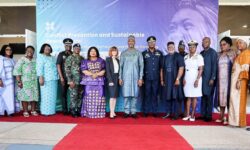By Derrick Senyo DIABA
You hear them all the time, words like digital, digitalize, and digitalization, they become an attractive trio that’s gives a feeling of modernity and contemporary living and lifestyle.
In their trail are equally attractive phrases like digital economy, cashless, e-pharmacy, fintech, aggrotech and the like, some are new coinages, and others having acquired new meanings but are all saying the same thing: the newly acquired digital taste and lifestyle of todays connected society.
As a people we have fallen in love with the speed, ease and convenience that digital systems offer, and have accepted them as our new normal.
USSD solutions or what we call ‘short code services’ have played a huge role in Africa, connection the unserved, and the unbanked to reliable banking services. Apps now pick up where USSDs ended, with the same objective, to digitalize systems and improve on the speed and security of digital transactions, and interactions.
On the social and entertainment side of things, we have big companies like Meta (Facebook, Instagram and WhatsApp) and Google (YouTube) that have become ubiquitous applications on the go, for a lot of us, a day is not complete without us visiting at least one of these pages.
Cloud computing technologies have also hastened the journey from analogous living to a digital ecosystem. While we relish our new and digital ways of living and doing things, we need to ask ourselves if we have the required infrastructure to support our digital lifestyle and economy. That is the main theme of this write-up: to investigate and appreciate the infrastructure that makes all these digital channels available to us in Africa.
The phrase digital infrastructure may mean many things to many people, but refers to the same niche, the backbone infrastructure that supports the new lifestyle of the modern society. The Sustainable Digital Infrastructure Alliance (www.sdialliance.com) defines digital infrastructure (DI) as “the total physical and software-based infrastructure necessary to deliver digital goods, products & services.
This includes data centers, fiber infrastructure, server hardware, personnel, IT virtualization & infrastructure software, operating systems, etc.” I will add that, this definition should also include the end-user equipment (say a mobile phone, a computer).
Closely connected to Digital Infrastructure (DI) is the Digital Public Infrastructure (DPI). In essence referring to the same thing but making a specific case for digital infrastructure for public use and gain, including the digital highways that support smart solutions, digital identification, e-governance etc.
The digital infrastructure ecosystem
That said, we note that the digital infrastructure ecosystem is made of 3 main subsystems:
- The data center environment [ Hardware and Software]
- The connecting medium
- The user equipment
The Data Center Environment:
The Data Centre Environment (DCE) contains the hardware and software that performs packet switching, forwarding, routing, application hosting, data storage. You will find equipment like servers, switches, routers, cloud platforms, content delivery and internet exchange setups in the DCE.
All DCEs require good cooling systems as these devices generate lots of heat and stable electricity supply to keep the DCE up 24/7. The DCE must be a controlled environment, with limited access to non-authorized persons, and strict privileges to personnel who work in the environment.
The Connecting Medium
The Connecting Medium (CM) is the next subsystem of the digital infrastructure ecosystem and concerns itself with carrying data from one point to another. This could be between datacenters, equipment rooms, cell sites and, from any of these points to the user premises and equipment.
The connecting medium of choice depends on the speed of connection required and the capacity of data connection desired. Other considerations such as ease of connecting medium deployment can also influence the CM of choice for a particular connection.
Typically, we have the following types of connecting medium.
- Wired connections (Fiber cables and copper cables)
- Wireless connections (Satellite connections and Microwave networks)
Fiber Optics Cables
Fiber cables are ideal for high-speed requirements and high volumes of data transportation from one point to the other, today’s fiber network is typically dimensioned in gigabits or terabit speeds and occupies a major chunk of our connectivity space. Fiber optics cables can be laid in the ground (terrestrial fiber), on erected poles (aerial fiber) or on sea and riverbeds (submarine fiber).
Typically, submarine fiber is ideal for connecting the continents and geographical blocks separated by the sea, and therefore controls over 90percent of all inter-continental communications. Ariel solutions are used typically to connect neighborhoods and communities, what is commonly referred to as Fiber to the home (FTTH), though it can be used for metro and regional connections.
Ground (duct) fiber is used to connect metropolis, regions/counties/states, and ideal for cross border uses cases among neighboring nations. Fiber optics cables can connect distances of over a 100km before requiring a data regeneration or refresh.
Copper Cables
Copper cables used to be in vogue until fiber technology became a commercial solution that could carry much more data and at much higher speeds than copper, thanks to breakthrough works by illustrious scientists including the late Ghanaian scientist, Dr. Thomas Owusu Mensah, whose work, made fiber optics cable a breakthrough product for data connectivity, far superior to the copper cables.
Today, copper is mostly used as an in-building solutions, occupying the local area network (LAN) environment, mostly connecting devices within the same building/office/home, carrying data typically in megabits and few gigabit speeds within short distances of about a 100m.
Microwave Networks
On the Wireless side, we will limit ourselves to just satellite and microwave solutions, as other wireless media like Bluetooth and infra-red are mostly for connection between users and have no application on the infrastructure backbone.
Microwaves have played very key roles in the GSM evolutions, connecting regional and metro networks with megabit and gigabit speeds, mostly used between the 2GHz and the 20GHz range.
These require spectrum allocation from the national regulator and also a clear line of site (LOS) between the two or more stations to be connected, in its evolution, we’ve had moved from point-to-point (PtP) microwave networks to Point-to-multiPoint (PtmP) networks, and some manufacturers even came up with None line of site (NLOS) solutions.
But the key factors remained unresolved, its open exposure means its unreliable in bad weather with occasional fading in severe harmattan conditions, and its short distance of transmission (Mostly around 30km or less with good line of sight), also it does not have the bandwidth capabilities of fiber networks and so could only play in the low bandwidth requirement space. Gradually the microwave network has become a last mile solution in most use cases.
Satellite Technology
Satellites on the other hand, after several years of decline seem to have been revived, they used to be the main medium for continental connection but could not support high bandwidth and the speed required for today’s data data-heavy applications.
Today, satellites play an indispensable role in connecting and observing our world and can be deployed as Geostationary Earth Orbit (GEO), or Medium Earth Orbit (MEO) or Low Earth Orbit (LEO). While they all have their advantages and disadvantages, what plays for our subject of interest is the LEO satellites as they can reduce latency drastically though not comparable to the speed of fiber optics networks and also increase throughput (capacity) of data.
Major players in the LEO market today are Starlink by Elon Musk, One Web and Kuiper by Jeff Bezos. There is renewed interest in satellites as a major backbone of our internet infrastructure, and we await the verdict in a few years time between fiber-based transmission and satellites-based transmission. For now, fiber is still king, especially on the backbone side of thing, while satellite is likely to make major inroads into the access side of things.
What next?
In our next write up, we shall look at how Africa is doing in building the required digital infrastructure to power its digital economy, we shall contrast progress in Africa and the rest of the world and look at our unique positioning as a continent in the emerging space of digital infrastructure.
>>>the writer is a data network infrastructure professional with over 15 years of impactful work in the design, deployment and operations of data network solutions. Having worked with global brands like Huawei, Airtel, Tigo and MTN, Derrick has contributed immensely to the growing digital connectivity revolution on the African continent, He has led cross-functional teams in the implementation of strategic network programs in Ghana, Cote D’Ivoire, Sierra Leone, Central African Republic, Nigeria, Kenya, Zimbabwe and South Africa, building Terabit optical and IP networks and empowering many business and individuals to live a digitally connected life. Derrick currently works with the Bayobab Group, as manager of network Infrastructure planning for West and Central Africa.
This article is part of a presentation he made at the recently held three-day TICON Africa 2024 conference in Mombasa, Kenya. He can be reached via [email protected]










